Enhancing growth and productivity in oil palm orchards requires a systematic approach that aligns with the specific requirements of each month. Farmers can optimize their cultivation practices and achieve higher yields by implementing month-wise operations. During the early months, emphasis is placed on land preparation, planting high-quality seedlings, and implementing irrigation systems.
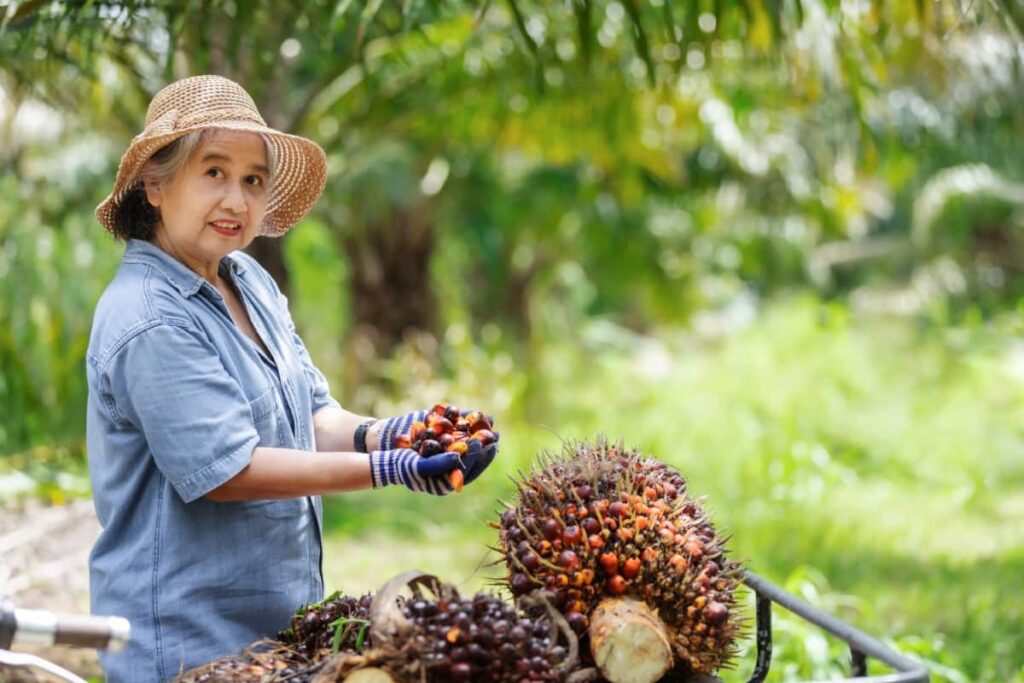
As the trees mature, weed and pest control measures become crucial. Pruning and fertilization are carried out to maintain tree health and promote optimal fruit production. Harvesting takes place in the later months, followed by post-harvest activities. Following a well-structured month-wise plan, oil palm farmers can maximize their orchard’s potential and ensure sustainable growth and productivity.
Oil Palm Orchard Management
What is Oil Palm Farming and its Overview?
Oil palm farming, scientifically known as Elaeis guineensis Jacq., originated in West Africa and is commonly referred to as African or red oil palm. It is a highly productive perennial crop renowned for its oil yield. The crop produces two types of oils: palm oil extracted from the fleshy mesocarp of the fruit, accounting for 45-55% of oil content, and palm kernel oil sourced from the kernel, which possesses lauric oil potential.
Oil palm plays a vital role in the global and Indian vegetable oil economy, with palm oil being widely accepted as a cooking medium due to its affordability. It is a raw material for producing oleo chemicals in various industries, including soap, candles, and plasticizer manufacturing. Additionally, it finds applications in edible oil, cosmetics, pharmaceuticals, biofuel, and bio-lubricant industries.
Oil palm cultivation is prevalent in Southeast Asian Nations (such as Malaysia, Indonesia, and Papua New Guinea), African countries (including Nigeria, Ivory Coast, Ghana, Liberia, and Cameroon), and South American countries (like Costa Rica, Panama, Colombia, and Brazil). Malaysia, Indonesia, and Nigeria are the primary oil palm producers globally. In India, oil palm was introduced at the National Royal Botanical Gardens in Kolkata in 1886.
Subsequently, the Maharashtra Association for Cultivation of Sciences (MACS) introduced African dura palms in Pune along canal bunds, home gardens, and forest lands between 1947 and 1959. Large-scale oil palm planting was initiated in Kerala by the Plantation Corporation of Kerala Ltd. and Andaman Forest and Plantation Development Corporation Ltd. in the Little Andaman Islands of the Andaman and Nicobar Islands between 1971 and 1985.
Importance of Month-Wise Planning for Oil Palm Orchard Maintenance
Each month presents unique requirements for optimal orchard management. By following a structured plan, farmers can ensure the timely execution of tasks such as land preparation, planting, irrigation, weed and pest control, pruning, fertilization, harvesting, and post-harvest activities. This approach maximizes productivity, minimizes risks, and promotes the sustainable growth of oil palm orchards. Proper month-wise planning is essential for achieving long-term success and profitability in oil palm farming.
In case you missed it: Almond Orchard Management: Month-by-Month Maintenance Guide for Maximum Yield
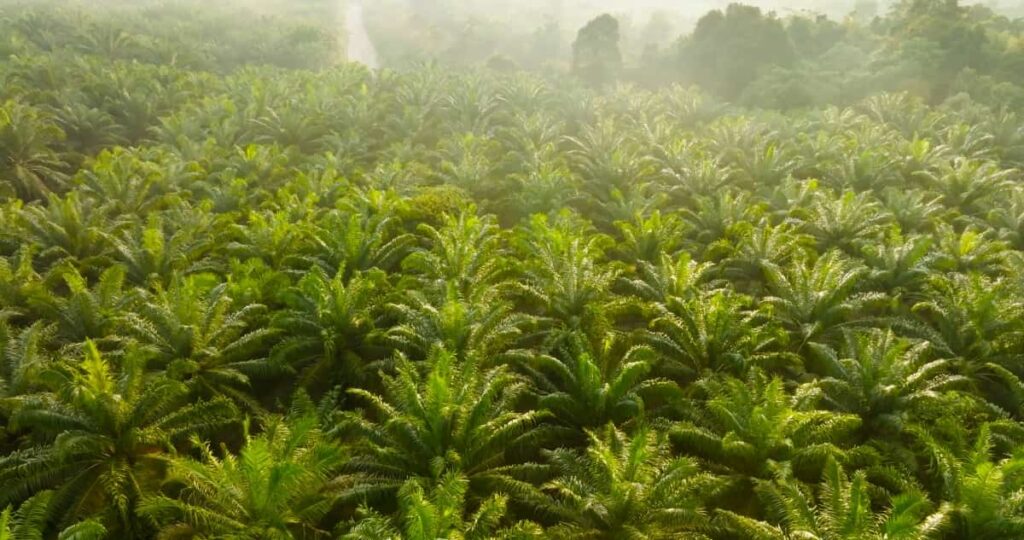
Best Tips for Growing Oil Palm Orchard Maintenance Practices
Climatic requirements: Oil palm thrives in a humid climate with evenly distributed rainfall of 150mm per month or 2500-4000mm per annum. It prefers temperatures between 29-33°C maximum and 22-24°C minimum, with at least 5 hours of bright sunlight daily. A high humidity of over 80% is essential for optimal growth.
Soils: Ideal soil conditions for oil palm include moist, well-drained, deep, loamy alluvial soils with good water permeability. The soil should have a minimum depth of one meter. Avoid highly alkaline, saline, waterlogged, and coastal sandy soils.
Cultivated variety: The most common hybrid variety is Tenera, which is a cross between thick-shelled Dura and shell-less Pisifera. Tenera has a thin shell with medium to high mesocarp and oil content.
Planting: The best season for planting is from June to December, during the monsoon. If planting during summer, ensure adequate irrigation, mulching, and cover crops like sun hemp to protect against hot winds. Use healthy seedlings 12-14 months old, with a height of 1-1.3 meters and 13 functional leaves. Maintain a spacing of 9 meters x 9 meters x 9 meters (triangular planting) with 143 plants per hectare. Plant them in pits measuring 60 cm x 60 cm x 60 cm.
Irrigation management: Oil palm requires sufficient irrigation, especially as it is a fast-growing crop with high productivity. Ensure there is assured and adequate irrigation available before planting. Mature palms of 3 years and above require a minimum of 150 to 200 liters of water per day, which may increase to 300 liters during hot summers. Basin or drip/microjet irrigation methods can be used based on water availability and soil type.
Fertilizer management: Oil palm is a nutrient-demanding crop and requires a balanced supply of macro, secondary, and micronutrients. Apply fertilizers every three months, starting from June/July. Incorporate organic matter and neem cake during the second dose of fertilizer application.
Basin management: Establish basins around the palm, with a radius of 1 meter in the first year, 2 meters in the second year, and 3 meters in the third year. Clean and weed the basins regularly to prevent competition for nutrients and water.
Weeding: Regular manual weeding or the use of recommended herbicides is necessary. Glyphosate is a recommended herbicide for effective weed control.
Inter-cropping: During the juvenile phase of the oil palm crop, inter-cropping can be practiced in inter- and intra-row spaces. Choose compatible crops that do not compete with oil palm for light, water, and nutrients. Suitable crops include vegetables, bananas, flowers, tobacco, chilies, turmeric, ginger, and pineapple.
Flowering, ablation, and pollination: Oil palm starts flowering around 14-18 months after planting. Ablation, removing early-stage male and female flowers, is recommended to promote stem growth and root development. Effective pollination can be achieved by pollinating insects like Elaeidobius kamerunicus.
Mulching: Mulch the oil palm basins using materials like dried leaves, male flowers, coconut husks, or empty bunches. This helps conserve moisture and control weeds.
Harvesting and yield: Harvest oil palm bunches at 10-12 day intervals or closed during the rainy season. In young plantations, there are more bunches with less weight, while in mature plantations, the bunch weight is higher, but the number of bunches is lower. Yield can range from 12 tonnes per hectare during the yield-stabilizing period (4-8 years) to 20 tonnes per hectare in yield-stabilized plantations (>8 years).
In case you missed it: Azolla Cultivation Business Plan: A Step-By-Step Guide for Growing, Care, Benefits
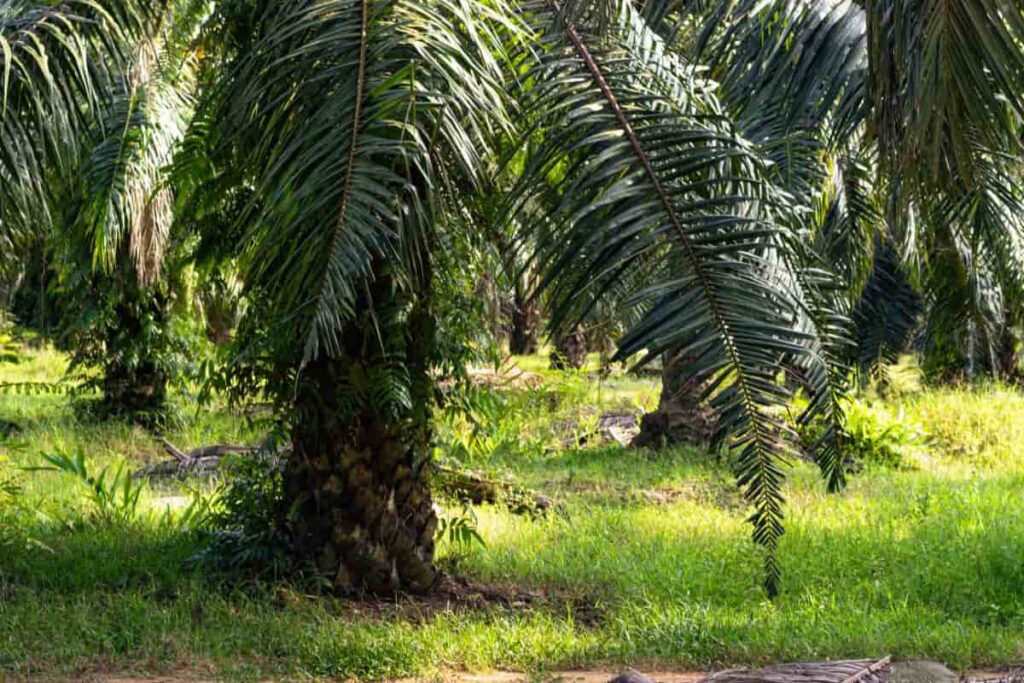
January Month Oil Palm Orchard Maintenance Planning
In January, for oil palm orchard maintenance planning, it is recommended to plant oil palm trees with a spacing of 9 meters using either a hexagonal or square method. Ensuring proper irrigation is crucial, with a recommended rate of 160 liters per palm per day in adult plantations.
Weed control can be achieved by applying weedicide, such as Glyphosate ammonia or Paraquat, at a ratio of 2.5 ml per liter of water in the palm basin. Fertigation should be carried out monthly, using 5 kg Urea, 3 kg DAP, and 5 kg MOP per acre in adult plantations. Ablation is recommended in juvenile plantations for up to 3 years using an ablation tool.
Mulching the palm basin with shredded leaves, male inflorescence, and empty fruit bunches is beneficial. When harvesting, a chisel in small plantations and a sickle attached to an aluminum pole in old plantations is recommended, leaving a 5 cm bunch stalk. It is advised not to plow in the oil palm basin.
February Month Oil Palm Orchard Maintenance Planning
For February, it is advised to follow a specific maintenance plan for oil palm orchards. Planting oil palm trees with a spacing of 9 meters using hexagonal or square methods and ensuring reliable irrigation is essential. In adult plantations, irrigation should be provided at 200 liters per palm per day. Monthly fertigation is recommended, using 5 kg Urea, 3 kg DAP, and 5 kg MOP per acre in adult plantations.
Additionally, micronutrients such as Magnesium sulfate at 250g/palm and Borax at 50g/palm should be applied. Ablation with an ablation tool benefits juvenile plantations for up to 3 years. Mulching the palm basin with shredded leaves, male inflorescence, and empty fruit bunches is advised.
Monitoring and controlling pests like bagworms, leaf webworms, and slug caterpillars is crucial. In case of infestation, lambda-cyhalothrin can be applied at 1ml/liter of water. When harvesting, a chisel in small plantations and a sickle attached to an aluminum pole in aged plantations is recommended, leaving a 5 cm bunch stalk. Plowing in the oil palm basin should be avoided.
March Month Oil Palm Orchard Maintenance Planning
In March, the maintenance plan for oil palm orchards includes the following activities: planting oil palm trees with a spacing of 9 meters using hexagonal or square methods and ensuring sufficient irrigation of 250 liters per palm per day in adult plantations. Monthly fertigation should be carried out using 5 kg Urea, 3 kg DAP, and 5 kg MOP per acre in adult plantations. Ablation with an ablation tool is recommended for juvenile plantations for up to 3 years.
In case you missed it: Optimizing Avocado Orchard Management: A Month-by-Month Maintenance Guide for Maximum Yield

Mulching the palm basin with shredded leaves, male inflorescence, and empty fruit bunches is beneficial. Harvesting should be done using a chisel in small plantations and a sickle attached to an aluminum pole in aged plantations, leaving a 5 cm bunch stalk. Basal application of fertilizer with specific quantities per palm or as per soil and leaf nutrient analysis can be adopted in adult oil palm plantations. Plowing in the oil palm basin should be avoided.
April Month Oil Palm Orchard Maintenance Planning
In April, the maintenance plan for oil palm orchards includes the following activities:
- Sowing sun hemp as a green manure crop in the palm basin during the juvenile period
- Providing irrigation at a rate of 265 liters per palm per day in adult plantations
- Applying weedicide in the palm basin with Glyphosate ammonia/Paraquat
- Monthly fertigation with 5 kg Urea, 3 kg DAP, and 5 kg MOP per acre in adult plantations
- Practicing ablation in juvenile plantations
- Mulching the palm basin with shredded leaves
- Male inflorescence, and empty fruit bunches
- Collecting soil and leaf samples for analysis
- Harvesting bunches with a chisel in small plantations, and a sickle attached to an aluminum pole in old plantations.
May Month Oil Palm Orchard Maintenance Planning
In May, the maintenance plan for oil palm orchards includes the following tasks: sowing the green manure crop, Sunhemp, within the basin of the juvenile plantation. Providing irrigation at a rate of 265 liters per palm per day in adult plantations, increasing to 350 liters per palm per day during severe summer conditions.
Monthly fertigation with 5 kg Urea, 3 kg DAP, and 5 kg MOP per acre for adult plantations. Practicing ablation in juvenile plantations for up to 3 years. Mulching the palm basin with shredded leaves, male inflorescence, and empty fruit bunches. Conducting need-based leaf pruning and retaining a minimum of 35 leaves per palm. Collecting soil and leaf samples for analysis, if not collected in April.
June Month Oil Palm Orchard Maintenance Planning
In June, the maintenance plan for oil palm orchards includes the following activities: planting oil palm with 9 m spacing using hexagonal or square methods and ensuring irrigation. Providing irrigation at a rate of 220 liters per palm per day in adult plantations, adjusting based on rainfall and moisture availability. Harvesting sun hemp and using it as mulch in the palm basin.
Monthly fertigation with 5 kg Urea, 3 kg DAP, and 5 kg MOP per acre for adult plantations. Applying basal fertilizer based on Urea, SSP, and MOP quantities per palm or as per soil and leaf nutrient analysis. Implementing ablation in juvenile plantations for up to 3 years. Applying chlorothalonil to manage bud rot and using phorate sachets to control Rhinoceros beetle. Harvesting bunches with a chisel in small plantations and a sickle attached to an aluminum pole in aged plantations, leaving only a 5 cm bunch stalk during harvesting.
July Month Oil Palm Orchard Maintenance Planning
For oil palm orchard maintenance in July, plant oil palm with 9 m spacing using hexagonal or square methods with assured irrigation. Provide irrigation at 120 liters per palm per day in adult plantations or adjust based on rainfall and moisture. Monthly fertigation with 5 kg Urea, 3 kg DAP, and 5 kg MOP per acre.
In case you missed it: Mastering the Dragon Fruit Orchard Management: A Month-by-Month Operations Guide for Maximum Yield
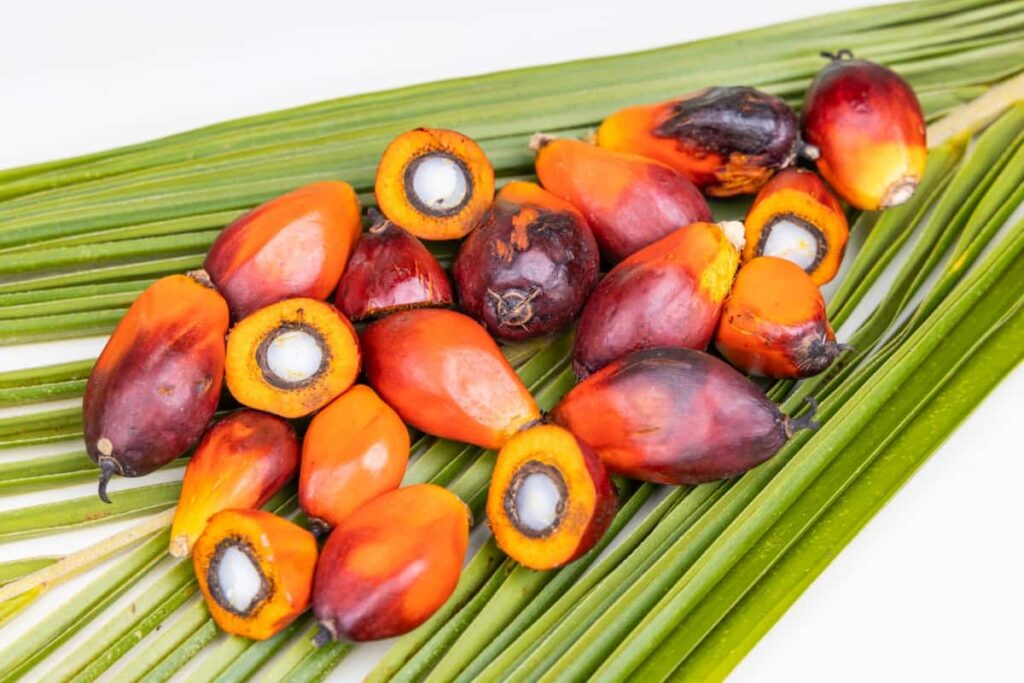
Implement ablation in juvenile plantations for up to 3 years. Apply chlorothalonil to manage bud rot and use phorate sachets to control Rhinoceros beetle. Harvest bunches using a chisel in small plantations and a sickle attached to an aluminum pole in aged plantations, leaving only a 5 cm bunch stalk during harvesting.
August Month Oil Palm Orchard Maintenance Planning
In August, plant oil palm with 9 m spacing using hexagonal or square methods with assured irrigation for oil palm orchard maintenance. Provide irrigation at 100 liters per palm daily in adult plantations, adjusting as needed based on rainfall and moisture. Implement monthly fertigation with 5 kg Urea, 3 kg DAP, and 5 kg MOP per acre. Apply micronutrients, such as Magnesium sulfate and Borax, to each palm. Practice ablation in juvenile plantations for up to 3 years. Mulch the palm basin with shredded leaves, male inflorescence, and empty fruit bunches.
September Month Oil Palm Orchard Maintenance Planning
For September’s oil palm orchard maintenance, plant oil palm with 9 m spacing using hexagonal or square methods and ensure irrigation is provided at 145 liters per palm per day in adult plantations, adjusting as needed based on rainfall and moisture. Implement monthly fertigation with 5 kg Urea, 3 kg DAP, and 5 kg MOP per acre.
Consider the basal application of fertilizer, including Urea, SSP, and MOP, per palm or based on soil and leaf nutrient analysis in adult oil palm plantations. Practice ablation in juvenile plantations for up to 3 years and mulch the palm basin with shredded leaves, male inflorescence, and empty fruit bunches.
October Month Oil Palm Orchard Maintenance Planning
In October, maintain your oil palm orchard by planting with 9 m spacing using hexagonal or square methods and ensuring irrigation at 140 liters per palm per day in adult plantations, adjusting as needed based on rainfall and moisture. Monitor for bagworms and leaf-eating caterpillars and apply lambda-cyhalothrin at a recommended dosage if necessary.
Implement monthly fertigation with 5 kg Urea, 3 kg DAP, and 5 kg MOP per acre. Practice ablation in juvenile plantations for up to 3 years and harvest bunches using appropriate tools. Consider intercropping in juvenile plantations, but avoid plowing, cutting, or tying leaves and planting intercrops in the palm basin.
November Month Oil Palm Orchard Maintenance Planning
In November, ensure proper maintenance of your oil palm orchard by planting with 9 m spacing using hexagonal or square methods and providing assured irrigation at 170 liters per palm per day in adult plantations, adjusting based on rainfall and moisture. To manage bud rot, apply chlorothalonil solution in the crown region. Protect against Rhinoceros beetles by using phorate sachets in the crown.
If not done earlier, collect soil and leaf samples for analysis. Implement monthly fertigation with recommended Urea, DAP, and MOP quantities per acre. Practice ablation in juvenile plantations and mulch the palm basin with shredded leaves, male inflorescence, and empty fruit bunches. Harvest bunches using appropriate tools and avoid cutting or tying the leaves.
In case you missed it: Optimizing Papaya Orchard Management: A Month-by-Month Operations Guide for Maximum Yield
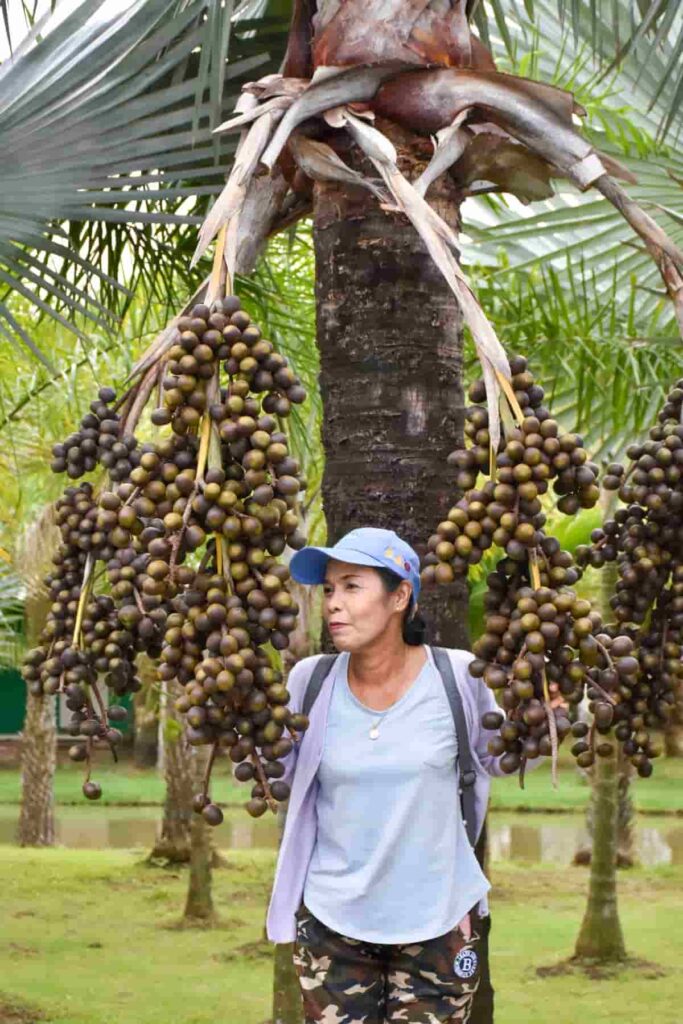
December Month Oil Palm Orchard Maintenance Planning
In December, maintain your oil palm orchard by planting with proper spacing and ensuring irrigation. Protect against bud rot by applying chlorothalonil solution. Provide irrigation at 160 liters per palm daily, adjusting as needed based on rainfall and moisture. Implement monthly fertigation using recommended Urea, DAP, and MOP quantities per acre. Consider the basal application of fertilizers based on soil and leaf nutrient analysis. Practice ablation in juvenile plantations and mulch the palm basin with organic materials.
Conclusion
Growers can optimize growth and productivity by implementing month-wise operations for oil palm orchards, such as proper planting, irrigation, fertigation, pest management, and harvesting techniques. These practices ensure healthy development, nutrient availability, and effective pest control, leading to improved oil palm yields.
- Management Pests and Diseases in Your Cotton Field
- Sheep Farming Business Plan for Beginners
- Aquaponic Farming at Home: A Step-By-Step Guide
- Profitable Village Farming Business Ideas in 2024
- High-Yield Aquaculture: Fast-Growing Fish for Farming
- Effective Fish Pond Construction Techniques for Beginners
- Irrigation and Water Management in Pineapple Farming
- Blossom to Harvest: Mastering Flowering and Pollination in Papaya Farming
- Pig Fattening Essentials: From Selection to Sale for Beginners
- Raising Wagyu Cattle: A Complete Guide for Premium Beef Production
- Soil Types and Their Water Holding Capacity
- Optimizing Irrigation Schedules for Coconut Groves for Enhanced Yield
- Espresso Your Garden: Coffee Grounds for Healthier Acid-Loving Plants
- The Best Soil Mix for Snake Plants: How to Mix Your Own Snake Plant Soil
- Green Thumb Success: Expert Tips for Cultivating Greenhouse Beans All Year Round
- Bloom All Year Round: The Ultimate Guide to Indoor Hyacinth Care
- Eco-Friendly Gardening: How to Make Liquid Fertilizer from Kitchen Waste
- Ultimate Guide to Grow Anise in Pots: Explore Seed Propagation to Harvesting
- Guide to Raising Chester White Pigs: Discover Breed Facts to Growth Management
- Mastering the Elegance: The Ultimate Guide to Weeping Cherry Tree Care, Planting, and Maintenance
- Ultimate Guide to Planting Garlic in Grow Bags: Growing Strategies for Beginners
- How to Fix Spider Plant Leaf-Related Problems: Natural and Organic Remedies
- 10 Reasons Why Your Tulsi Plant is Shedding Leaves: Home Remedies and Solutions
- Optimizing Growth and Yield: The Advantages of Palm Bunch Ash Fertilizer
- Utilizing Neem Oil Extract as a Natural Pesticide for Hydrangea
- From Soil to Harvest: Various Ways in Which Farmers Can Use AI Tools
- Steps to Encourage and Induce Citrus Flowers: A Comprehensive Guide
- How to Fix Snake Plant Leaf-Related Issues: Natural and Organic Remedies
- Transform Your Garden into a Fragrant Oasis with Raat Ki Rani (Night Blooming Jasmine)
- Discover the Ideal Chicken Breeds for Philippine Farms
- How to Create a Poultry Egg Farm Business Plan for Profits
- Grow Lemon Cucumbers Like a Pro: Insider Techniques for Bountiful Yields
- Ultimate Guide to Caring for Your Pink Princess Philodendron: Tips for Thriving Variegation
- Areca Nut Profit Per Acre: Calculating Yield and Cost of Cultivation
- How Kaveri Chicken is Becoming a More Profitable Breed in Indian Backyards
- Transform Your Barn: 9 Steps to Convert a Horse Stall into a Chicken Coop
